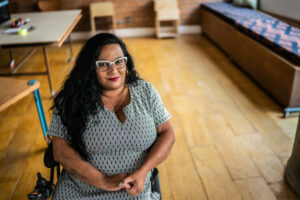International Women’s Day – a global day to celebrate the achievements of women, raise awareness about discrimination and highlight the actions we can take to reach gender equality – falls on Friday 8th March.
 The global awareness day, which isn’t country, group or organisation specific, was first held in March 1911, when it was supported by over a million people. It has since evolved into a day of collective global activism and celebration.
The global awareness day, which isn’t country, group or organisation specific, was first held in March 1911, when it was supported by over a million people. It has since evolved into a day of collective global activism and celebration.
As well as being a day to celebrate and highlight the social, economic, cultural and political achievements of women, International Women’s Day also serves as a call to action for accelerating women’s equality.
The idea is simple: do what you can to support and advance women.
A day to focus on equality, diversity, inclusion and human rights, the point of International Women’s Day is that it belongs to everyone, and any action to mark it is valid.
Inspire inclusion this International Women’s Day
This year, the campaign theme is Inspire Inclusion.
The dedicated International Women’s Day website says this theme was chosen because:
“When we inspire others to understand and value women’s inclusion, we forge a better world. And when women themselves are inspired to be included, there’s a sense of belonging, relevance and empowerment.
“Collectively, let’s forge a more inclusive world for women.”
 It calls on everyone to take action for inclusion. This includes calling out poor practice and discrimination, and challenging the absence of women in key spaces.
It calls on everyone to take action for inclusion. This includes calling out poor practice and discrimination, and challenging the absence of women in key spaces.
It means including women of all races, ages, abilities, faiths, body types and identities.
Individuals, organisations and groups can all take part and fight for inclusion at work, at home, in school and in the community.
There are suggested ways that organisations and groups can #InspireInclusion and ensure that women and girls are valued. These include:
- Fighting for women’s economic empowerment
- Recruiting, retaining and developing diverse talent
- Supporting women and girls into leadership, decision-making, business and STEM roles
- Designing and building infrastructure that meets the needs of women and girls
- Helping women and girls to make informed decisions about their health
- Providing women and girls across the world with access to quality education and training
- Elevating women and girl’s participation and achievement in sport
- Promoting the creative and artistic talents of women and girls
This International Women’s Day, people are being invited to show their support for women and the 2024 theme and inspire others to fight for an inclusive world by striking the special #InspireInclusion pose, which involves making the shape of a love heart with your hands. These pictures can then be shared on social media with the hashtags #InspireInclusion and #IWD2024.
According to the official website, this pose has been chosen because:
“When we truly value difference, inclusion comes from the heart.”
Individuals and organisations can even submit their #InspireInclusion photo and statement to the website. Some may be featured in the International Women’s Day 2024 image gallery.
Women, equality and the workplace
Ipsos’ annual International Women’s Day survey found that nearly half of Britons now believe that the fight for women’s equality has gone far enough in Great Britain.
 The global study was carried out in 31 countries in collaboration with the Global Institute for Women’s Leadership at King’s College London University.
The global study was carried out in 31 countries in collaboration with the Global Institute for Women’s Leadership at King’s College London University.
Data for Great Britain shows that 47% think that, when it comes to giving women equal rights with men, things have gone far enough in Great Britain. This compares to 38% who responded in the same way last year. Focusing specifically on men, the majority (56%) now hold this view, compared to 39% of women.
Nearly half of respondents (47%) also said that the fight for women’s equality has gone so far that we are now discriminating against men. This figure was 59% for men and 35% for women.
This makes for potentially depressing reading given that, objectively, women still do not have equality with men.
According to the Office for National Statistics (ONS) Labour Force Survey, the female employment rate was 72.1% in October to December 2023, compared to 78.1% for men. Of those women in work, nearly 4 in 10 (38%) were employed part-time, compared to just 14% of men.
Meanwhile, the ONS Annual Survey of Hours and Earnings found that the median weekly pay for female full-time employees was £629 in April 2023, compared to £725 for male full-time employees. The gender pay gap was 7.7% for full-time employees and 14.3% for all employees.
A House of Commons research briefing on Women and the UK economy explains:
“The gender pay gap for all employees is larger than either the full-time or part-time pay gaps. This is because more women than men are employed part time and part-time workers tend to earn less per hour than those working full time.”
 In addition, the briefing notes that less than 1 in 5 (18%) of the UK’s small and medium-sized enterprises with employees were run by women in 2022 (figures from the Government’s annual Small Business Survey).
In addition, the briefing notes that less than 1 in 5 (18%) of the UK’s small and medium-sized enterprises with employees were run by women in 2022 (figures from the Government’s annual Small Business Survey).
There are some signs of progress, however, with 42.6% of FTSE100 and 42.1% of FTSE350 directorships being occupied by women in January 2024. Additionally, around half of all new FTSE100 board appointments (47%) were women.
The Ipsos survey did find that the majority of the British public perceived male and female political and business leaders as equally competent. In the workplace, 6 in 10 Britons (61%) said they had no preference in the gender of their boss.
‘Ongoing national conversation’ needed beyond International Women’s Day
The Chief Executive of Ipsos UK and Ireland, Kelly Beaver MBE, says the findings show that we can’t rely solely on International Women’s Day to highlight the importance of workplace equality and instead need to engage in an “ongoing national conversation” in order to drive change.
She commented:
“The findings of our research serve as a salutary reminder that the concept of gender equality in the workplace and its impact on our wider society is more complex than we sometimes think.
“Whilst the boards of FTSE350 companies are now 42% female, more needs to be done to explain the practical benefits that a greater diversity of perspective can bring to business rather than taking it for granted that equality in the workplace will be universally welcomed as a good thing in itself.
“Gender equality can only become a reality if both men and women buy into the advantages of re-imagining the workplace so that it becomes more family friendly for all, not a competition between genders, but our research found that a majority of men now believe gender equality has gone too far. This suggests there needs to be an ongoing national conversation about the practicalities of achieving true equality and how barriers to change can be broken down without alienating half of the population.”
Gender equality in the workplace has been shown to benefit both male and female employees through:
- Increased job satisfaction
- Increased productivity
- Lower job turnover
- New ideas and innovation
Indeed, across the world, workplace gender equality is associated with improved national productivity and economic growth.
A focus on women’s health and safety for International Women’s Day
When it comes to health, safety and wellbeing at work, there are marked differences between the genders.
 The Health and Safety Executive’s (HSE) annual statistics on work-related injuries and ill-health show that men are much more likely to be killed or seriously injured by their work, while women were significantly more likely to experience work-related ill-health.
The Health and Safety Executive’s (HSE) annual statistics on work-related injuries and ill-health show that men are much more likely to be killed or seriously injured by their work, while women were significantly more likely to experience work-related ill-health.
In 2022-23, 96% of all worker fatalities occurred to male workers. This is broadly similar to previous years. Deaths linked to past exposures at work were also more likely to occur in male workers. Of the 13,000 total estimated annual deaths, 75% are male.
The non-fatal injury rate was also statistically significantly higher for male workers, at 1,810 per 100,000 workers compared to 1,480 per 100,000 for female workers.
But when it comes to work-related ill-health, female workers had a statistically significantly higher prevalence rate than male workers at 5,880 per 100,000 workers compared to 4,610 per 100,000 for men.
The HSE says that the underlying risk of work-related ill-health or injury differs from one worker to the next and depends upon several factors, including their occupation, the length of time they have been doing their job and the industry in which they work.
Therefore, the differences in workplace injury and work-related ill-health rates among men and women will be largely driven by their different employment profiles.
The most hazardous industries such as construction, mining, manufacturing and agriculture are still dominated by men, leading them to experience higher rates of injury and death. This also explains why significantly more men than women die each year as a result of past exposures at work; there are, and have been, more men than women employed in industries where exposure to workplace hazards such as asbestos, silica dust and diesel engine exhaust emissions were commonplace.
Women, meanwhile, more heavily dominate sectors such as long-term care, where pay and working conditions are typically relatively poor and the work is physically and mentally demanding. This can lead to high rates of work-related ill-health, such as stress, depression and anxiety or musculoskeletal disorders (MSDs).
A gender-sensitive approach to occupational safety and health
The EU-OSHA says there are key differences that affect the occupational safety and health (OSH) risks that men and women face. They say that, for women, the following factors need to be considered:
- They often work in specific sectors and carry out specific types of work
- They often balance dual responsibilities at work and home
- They are underrepresented at supervisor and management level, meaning their needs may be less understood or attended to
- May carry out jobs that are often incorrectly assumed to be safe or easy
The EU-OSHA says that these differences as well as workload and stress-related risks to women in the workplace are often not recognised or underestimated in OSH practice.
Indeed, an International Labour Organisation (ILO) report on equality at work (2009) states that “occupational safety and health (OSH) hazards affecting women workers have been traditionally under-estimated because OSH standards and exposure limited to hazardous substances are based on male populations and laboratory tests.”
It also outlined how woman can face more instability in their work and are more present in informal workspaces:
“Women are more likely than men to have low paid jobs and are less likely than men to be supervisors and managers. A significant proportion of women can also be found in the informal economy where they face unsafe and unhealthy working conditions, low or irregular incomes, job insecurity and lack of access to information, markets, finance, training and technology.”
Calling for a “gender-sensitive approach to OSH”, the EU-OSHA says that employers can take the following steps to ensure protection and benefit everyone:
- Aim to make work safer and easier for everyone
- Include gender issues and differences in workplace risk assessments
- Look at the real work done and avoid assumptions about who is at risk and why
- Offer flexibility in working hours
- Involve women in OSH decision-making
 We can also help to transform the approach and make the world of work safer for women by raising the profile of women in the OSH sector and encouraging more women into OSH roles.
We can also help to transform the approach and make the world of work safer for women by raising the profile of women in the OSH sector and encouraging more women into OSH roles.
Speaking to the Institution of Occupational Safety and Health (IOSH) in May last year, Jessy Gomes CMIOSH, Technical Safety Systems Lead at University College London, admitted it could be “a really intimidating environment,” because of the often disproportionate number of men but that it was important for women to push through and find their voice.
She said that other women in the sector had championed and supported her as she progressed in her career, and that support from male colleagues was also valuable.
Becoming an IOSH committee member early in her career helped Jessy gain confidence and develop her knowledge and skill base. Now she says that workplaces can push towards becoming more equal by harnessing the power of emotional intelligence:
“Be empathetic, listen to people and be attentive to behaviour. Sometimes women watch themselves and don’t say how they feel in a professional setting. We need men to use their emotional intelligence to gauge if something is not right.”
She also added:
“Kindness is underrated in the workplace. It can be a cut-throat environment for women, which is why so many working mothers leave and young people don’t join – they don’t feel welcome. I was tempted to quit many times in my early career when I felt intimidated.”
A focus on women in the caring industries for International Women’s Day
As stated above, women still dominate the caring industries.
In 2019, the OECD found that 75% of the health and social workforce were women, equating to around 20 million workers.
 However, women working in this sector were often in lower-paid roles. They cite the example of female doctors. In 2015, up to 47% of doctors across the OECD were female, but female doctors still tend to earn less than male doctors because they are under-represented in the highest-paid specialisms, such as surgery.
However, women working in this sector were often in lower-paid roles. They cite the example of female doctors. In 2015, up to 47% of doctors across the OECD were female, but female doctors still tend to earn less than male doctors because they are under-represented in the highest-paid specialisms, such as surgery.
When focusing on the long-term care sector, women were found to occupy around 90% of the roles.
But, as noted earlier, working conditions in this sector tend to be relatively poor, with lower pay, long hours and demanding work. Indeed, OECD data suggests that 1 in 6 workers in the long-term care sector across all EU countries reported suffering from at least one health condition that was caused or made worse by their work.
In addition to dominating the long-term care sector, women are also still more likely to provide informal care than men are.
Across the OECD, around 60% of informal carers aged over 50 are women. Informal carers are less likely to be able to engage in paid work and are more likely to suffer from mental health problems. In most countries, informal caregiving is associated with a higher probability of experiencing poverty, and women are disproportionately affected.
 Women also heavily dominate the early years and childcare sector. The government’s Childcare and early years provider survey found that, in 2023, the overwhelming majority of paid childcare staff were female:
Women also heavily dominate the early years and childcare sector. The government’s Childcare and early years provider survey found that, in 2023, the overwhelming majority of paid childcare staff were female:
- 98% of staff in all school-based providers were female
- 98% of staff in all group-based providers were female
- 97% of childminders were female
The disproportionate number of women working in early years and childcare roles can help to perpetuate gender stereotypes that only women are suited to looking after children or general caregiving.
And, again, while incredibly important, these roles tend to be low-paid with long hours and physically and emotionally demanding work. The workload and risks also tend to be underestimated and undervalued by society.
Redressing the balance this International Women’s Day
The main message of International Women’s Day is that we can pish forward and effect change to create a more equal world.
Jessy Gomes CMIOSH advises that one key move that employers can make is to report their gender pay gap. She says:
“Provide your report, find out the data and rectify any pay gaps that are currently in place. This is an immediate action that employers could take.
“Another one is looking at what the organisation is doing to support women – and I don’t mean just sending them onto a leadership programme and then forgetting about them. It’s about providing them with ongoing support, coaching, mentoring and sponsorship.”
Government advice and information pages on closing the gender pay gap outline some key actions that employers can take. These include:
For recruitment:
- Include more than one woman in shortlists for recruitment and promotions
- Use skills-based assessment tasks
- Use structured interviews, asking exactly the same questions of all candidates
- Have diverse selection panels
- Encourage salary negotiation by showing salary ranges
- Widen your potential applicant pool
For workplace culture and support:
- Ensure promotion, pay and reward processes are transparent
- Appoint diversity managers and task forces
- Review use of performance self-assessments
- Set specific, time-bound internal targets
- Carry out staff surveys and exit interviews
- Provide staff with unconscious bias training
- Improve flexible working options
- Ensure part-time employees have equal access to training and development
- Help all staff to progress through equal access to measures such as training and development, mentoring, networking programmes and performance feedback
- Raise awareness of Shared Parental Leave (SPL), paternity leave and flexible working
 Steps such as providing clear guidance about SPL, paternity leave and flexible working, running awareness campaigns and increasing pay for people on paternity leave and SPL can help to encourage more male employees to play a role in childcare, which can help to resolve gender imbalances in the workplace.
Steps such as providing clear guidance about SPL, paternity leave and flexible working, running awareness campaigns and increasing pay for people on paternity leave and SPL can help to encourage more male employees to play a role in childcare, which can help to resolve gender imbalances in the workplace.
Many occupational safety and health bodies, such as IOSH, have argued that a people-focused work culture and improved flexible working options are good for all businesses and their employees.
Activist Anna Whitehouse (a.k.a ‘Mother Pukka’) has run the ‘Flex Appeal’ campaign since 2015, fighting for greater adoption of flexible working for the benefit of all employees and employers.
Her ‘Flexonomics’ report, produced in partnership with Sir Robert McAlpine in 2021, revealed that flexible working arrangements contribute £37 billion to the UK economy. The report also forecasts that a 50% increase in the current rate of flexible working could result in a huge net economic gain of £55 billion, with the creation of 51,200 new jobs.
The findings bear repeating as we approach International Women’s Day and refocus our efforts to create gender equality in the workforce and wider society.
Anna has long argued that more flexible working is the key to closing the gender pay gap, creating more inclusive workplaces, boosting productivity and improving work-related mental health.
Publishing the report, she explained:
“Flexible working has never been about location. It’s always been about inclusion. It’s about including talent. Talent with caring responsibilities, talent living with disabilities. People who are looking to work in a human – or even humane – way that’s ultimately good for business.
“Now we can prove that there’s a direct link between flexibility and profitability. That an uptake in flexible working will boost the UK economy, too. If we want to ‘Build Back Better’, now is the time for businesses to use flexible working as the foundation.
“Flexible working opens doors, lets people in, and ultimately drives profit to the bottom line.”
Inspire inclusion in the workplace
First Response Training (FRT) is one of the UK’s largest and leading national training providers.

They deliver a wide and diverse range of training for businesses and organisations across all industry sectors and throughout the UK. Their course range includes training in the fields of health and safety, first aid, fire safety, manual handling, mental health, food safety, health and social care and more.
Their training is mapped to current UK standards and legislation and follows relevant industry guidelines, such as those issued by the Health and Safety Executive (HSE), Skills for care, the Care Quality Commission and the Resuscitation Council UK.
It includes training awards in Equality, Diversity and Inclusion, as well as many more subjects.
Based on a common sense, proportionate approach to workplace safety, training helps learners to understand the true benefits of creating a healthy, safe and inclusive environment at work but also underlines how it must go beyond training to ensure a full organisational approach and culture.
Ahead of International Women’s Day 2024, a trainer from FRT explains:
“At FRT we are looking forward to celebrating International Women’s Day and remembering the fantastic achievements of women across the world and throughout history.
“But we must also remember this Friday the work that still needs to be done to ensure an equal world of work. International Women’s Day should serve as a reminder for all employers that if the workplace is not fully inclusive – which includes being safe, supportive and enabling for all workers – then you are potentially missing out on diverse talent, ideas, perspectives and experience.
“Protecting the health, safety and welfare of employees goes far beyond minimising risks to their physical safety and really requires a holistic approach to ensure they are properly supported and have a positive and equal experience in the workplace.
“Within our own organisation we ensure fair and transparent pay and reward structures, as well as learning, development and feedback programmes. We have flexible working arrangements in place, with opportunities for all employees.”
For more information on any of the training courses that FRT can provide, please call them today on freephone 0800 310 2300 or e-mail info@firstresponsetraining.com.
